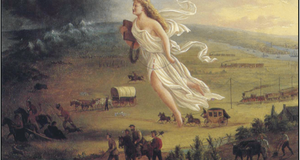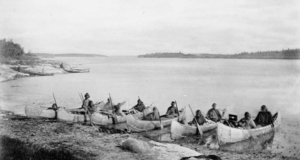|
The Mystery of Miracles: Examining Religious Providence in the Sixteenth-Century Captivity Narratives of Hans Staden and Cabeza de Vaca
Rolena Adorno introduces what may seem a surprising assertion – that the natives constructed this miraculous reality to gain favor from surrounding aboriginal communities: “…He [Cabeza de Vaca] described how the natives instructed other groups to spread this account of the Spaniards to inspire aboriginal generosity toward them. Did he see this declaration not as the belief of some native groups but as a ruse perpetrated by others?” she asks. This could explain the widespread and unexplained healing that took place, particularly the resurrection of the dead man. Was it all a show by the natives? There are certain problems with this theory, of course – how would all of them have agreed upon such a complicated plan, and when would they have had time to do so? Cabeza de Vaca was neither an expected nor a recognized visitor. Nonetheless, the idea is an interesting and a viable one. Other historians, including Santiago Juan-Navarro and Theodore Young, support Adorno’s hypothesis: “The miracles could very well be due to the active propaganda effected by those indigenous people who accompanied Cabeza de Vaca and who benefitted from the healing practices.” This may take blame off of the Narváez crew, but could such a theory be extended to Staden as well? Could native collusion and conscious self-fashioning on the part of European explorers both have occurred?
Obviously, the subject of miracles is no easy one to decipher. There are many possible explanations for them, explanations that lead to an infinite combination of feasible truths. Juan-Navarro and Young, however, warn us to be cautious even when using the word “miracle” – it was a modern historian, López de Gómara, who first used the word to describe the healing practices of Cabeza de Vaca, a description which we have now come to accept but which was never explicitly used by either explorer: “While the terms in which Cabeza de Vaca describes these events are ambiguous, those in which later historians pronounced were less and less so, eventually becoming certitudes.”
Is it possible that these men simply wrote what they experienced, innocently translating memories – which were tainted by fear and desperation – into religious providence? Perhaps it is us who have made more of these “miracles” than they merit. If divine intervention cannot explain the extraordinary experiences of Cabeza de Vaca and Hans Staden, the truth certainly lies within the complex field of human psychology.
Adorno, R. The Negotiation of Fear in Cabeza de Vaca’s ‘Naufragios’. Representations 1991; 33:163–199.
Cabeza de Vaca, Á.N. Naufragios. In: Adorno, R., Pautz, P.C., eds. The Narrative of Cabeza de Vaca. (Lincoln: University of Nebraska Press, 2003), 1–146.
Jong Lee, K. Pauline Typology in Cabeza de Vaca’s ‘Naufragios’. Early American Literature 1999; 34.3: 241–262.
Juan-Navarro, S., Young, T.R. A Twice-Told Tale: Reinventing the Encounter in Iberian/Iberian American Literature and Film. (Newark: The University of Delaware Press, 2001), 74–75.
Reff, D.T. Text and Context: Cures, Miracles, and Fear in the Relación of Álvar Núñez Cabeza de Vaca. Journal of the Southwest 1996; 38.2:115–138.
Staden, H. The True History and Description of a Country Populated by Wild, Naked, and Savage Man-munching People, Situated in the New World, America… In: Whitehead, N.S., Harbsmeier, M., eds. Hans Staden’s True History: An Account of Cannibal Captivity in Brazil. (Durham: Duke University Press, 2008), xv–176.
TenHuisen, D.R. Providence and Passio in Hans Staden’s ‘Warhaftig Historia’. Daphnis-Zeitschrift für Mittlere Deutsche Literatur 2004; 33.1-2:213–254.
Villas Bôas, L. Wild Stories of a Pious Travel Writer: The Unruly Example of Hans Staden’s ‘Warhaftig Historia’. Daphnis-Zeitschrift für Mittlere Deutsche Literatur 2004; 33.1-2:187 –212.
1.) Adorno & Pautz, 14.
2.) Cabeza de Vaca, 86.
3.) Whitehead & Harbsmeier, c.
4.) Ibid.
5.) Ibid.
6.) Villas Bôas, 192.
7.) Whitehead & Harbsmeier (Dryander), 10.
8.) TenHuisen, 216.
9.) Ibid., 217.
10.) Ibid., 248.
11.) Jong Lee, 242.
12.) Ibid., 243.
13.) Ibid.
14.) Ibid., 241-242.
15.) Reff, 117.
16.) Ibid.
17.) de Vaca, 93.
18.) Ibid.
19.) Adorno, 168.
20.) de Vaca, 114.
21.) Ibid., 117-118.
22.) Ibid., 119.
23.) Staden, 75.
24.) Ibid.
25.) Ibid., 71.
26.) Ibid.
27.) de Vaca, 146.
28.) Adorno, 192.
29.) Juan-Navarro & Robert Young, 75.
30.) Ibid., 74.
31.) Ibid., 75.
Adorno, R. The Negotiation of Fear in Cabeza de Vaca’s ‘Naufragios’. Representations 1991; 33:163–199.
Cabeza de Vaca, Á.N. Naufragios. In: Adorno, R., Pautz, P.C., eds. The Narrative of Cabeza de Vaca. (Lincoln: University of Nebraska Press, 2003), 1–146.
Jong Lee, K. Pauline Typology in Cabeza de Vaca’s ‘Naufragios’. Early American Literature 1999; 34.3: 241–262.
Juan-Navarro, S., Young, T.R. A Twice-Told Tale: Reinventing the Encounter in Iberian/Iberian American Literature and Film. (Newark: The University of Delaware Press, 2001), 74–75.
Reff, D.T. Text and Context: Cures, Miracles, and Fear in the Relación of Álvar Núñez Cabeza de Vaca. Journal of the Southwest 1996; 38.2:115–138.
Staden, H. The True History and Description of a Country Populated by Wild, Naked, and Savage Man-munching People, Situated in the New World, America… In: Whitehead, N.S., Harbsmeier, M., eds. Hans Staden’s True History: An Account of Cannibal Captivity in Brazil. (Durham: Duke University Press, 2008), xv–176.
TenHuisen, D.R. Providence and Passio in Hans Staden’s ‘Warhaftig Historia’. Daphnis-Zeitschrift für Mittlere Deutsche Literatur 2004; 33.1-2:213–254.
Villas Bôas, L. Wild Stories of a Pious Travel Writer: The Unruly Example of Hans Staden’s ‘Warhaftig Historia’. Daphnis-Zeitschrift für Mittlere Deutsche Literatur 2004; 33.1-2:187 –212.
1.) Adorno & Pautz, 14.
2.) Cabeza de Vaca, 86.
3.) Whitehead & Harbsmeier, c.
4.) Ibid.
5.) Ibid.
6.) Villas Bôas, 192.
7.) Whitehead & Harbsmeier (Dryander), 10.
8.) TenHuisen, 216.
9.) Ibid., 217.
10.) Ibid., 248.
11.) Jong Lee, 242.
12.) Ibid., 243.
13.) Ibid.
14.) Ibid., 241-242.
15.) Reff, 117.
16.) Ibid.
17.) de Vaca, 93.
18.) Ibid.
19.) Adorno, 168.
20.) de Vaca, 114.
21.) Ibid., 117-118.
22.) Ibid., 119.
23.) Staden, 75.
24.) Ibid.
25.) Ibid., 71.
26.) Ibid.
27.) de Vaca, 146.
28.) Adorno, 192.
29.) Juan-Navarro & Robert Young, 75.
30.) Ibid., 74.
31.) Ibid., 75.
Save Citation » (Works with EndNote, ProCite, & Reference Manager)
APA 6th
Raubaugh, L. E. (2012). "The Mystery of Miracles: Examining Religious Providence in the Sixteenth-Century Captivity Narratives of Hans Staden and Cabeza de Vaca." Inquiries Journal/Student Pulse, 4(07). Retrieved from http://www.inquiriesjournal.com/a?id=659
MLA
Raubaugh, Lauren E. "The Mystery of Miracles: Examining Religious Providence in the Sixteenth-Century Captivity Narratives of Hans Staden and Cabeza de Vaca." Inquiries Journal/Student Pulse 4.07 (2012). <http://www.inquiriesjournal.com/a?id=659>
Chicago 16th
Raubaugh, Lauren E. 2012. The Mystery of Miracles: Examining Religious Providence in the Sixteenth-Century Captivity Narratives of Hans Staden and Cabeza de Vaca. Inquiries Journal/Student Pulse 4 (07), http://www.inquiriesjournal.com/a?id=659
Harvard
RAUBAUGH, L. E. 2012. The Mystery of Miracles: Examining Religious Providence in the Sixteenth-Century Captivity Narratives of Hans Staden and Cabeza de Vaca. Inquiries Journal/Student Pulse [Online], 4. Available: http://www.inquiriesjournal.com/a?id=659
Suggested Reading from Inquiries Journal
This paper explored the role of Native Americans in the Hollywood film industry and their actions to establish authentic representations of their population and culture in the media. Using academic literature, film analyses, and contemporary film reviews and articles, the author created a synthesis of the history of Native Americans... MORE»
This article compares the media's framing of five groups in response to a societal catalyst that propelled them into the public and media spotlight: Native Americans during the Indian Wars; women during the suffrage movement; African Americans during the Civil Rights Movement; Japanese Americans following the attacks on Pearl Harbor... MORE»
The term ‘nation’ is notoriously hard to define, not only because it has multiple meanings, but because the prevailing definitions change in response to various social and political factors (Ozkirimli 2000).... MORE»
The prevalence of methamphetamine (ME) use among American Indians and Native Alaskans (AI/NAs) is strikingly high in comparison to other ethnic groups in the U.S. (Iritani, Dion Hallfors & Bauer, 2007). However, few datasets are available that allow for estimates to characterize the problem or describe the variation of the ME problem among tribes. Only recently has anecdotal information emerged about the spread of ME use and manufacture into... MORE»
Latest in History
2022, Vol. 14 No. 02
India was ruled by the Timurid-Mughal dynasty from 1526 to 1857. This period is mainly recognised for its art and architecture. The Timurid-Mughals also promoted knowledge and scholarship. Two of the Mughal emperors, Babur and Jahangir, wrote their... Read Article »
2022, Vol. 14 No. 02
The causes of the First World War remains a historiographical topic of contention more than 100 years on from the start of the conflict. With the passing of the centenary in 2014, a new wave of publications has expanded the scope and depth of historians... Read Article »
2021, Vol. 13 No. 11
The Sino-Vietnamese War remains one of the most peculiar military engagements during the Cold War. Conventional wisdom would hold that it was a proxy war in the vein of the United States’ war in Vietnam or the Soviet invasion of Afghanistan... Read Article »
2021, Vol. 13 No. 11
While the Cold War is popularly regarded as a war of ideological conflict, to consider it solely as such does the long-winded tension a great disservice. In actuality, the Cold War manifested itself in numerous areas of life, including the various... Read Article »
2021, Vol. 13 No. 11
This article analyzes the role of musical works in the United States during World War II. It chronologically examines how the social and therapeutic functions of music evolved due to the developments of the war. This article uses the lyrics of wartime... Read Article »
2021, Vol. 13 No. 10
Early medieval Irish society operated on an elaborate power structure formalized by law, practiced through social interaction, and maintained by tacit exploitation of the lower orders. This paper investigates the materialization of class hierarchies... Read Article »
2021, Vol. 13 No. 05
Some scholars of American history suggest the institution of slavery was dying out on the eve of the Civil War, implying the Civil War was fought over more generic, philosophical states' rights principles rather than slavery itself. Economic evidence... Read Article »
|

















